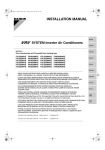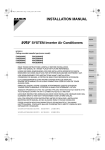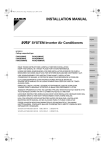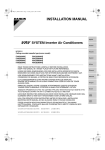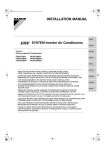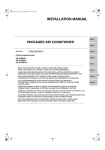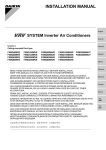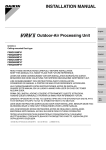Download Daikin FXHQ100MAVE Installation manual
Transcript
00_CV_3P086154-2P.fm Page 1 Tuesday, March 31, 2009 5:33 PM INSTALLATION MANUAL English SYSTEM Inverter Air Conditioners Deutsch MODELS Floor standing type and Concealed floor standing type FXLQ20MVE FXLQ25MVE FXLQ32MVE FXLQ40MVE FXLQ50MVE FXLQ63MVE FXNQ20MVE FXNQ25MVE FXNQ32MVE FXNQ40MVE FXNQ50MVE FXNQ63MVE FXLQ20MAVE FXLQ25MAVE FXLQ32MAVE FXLQ40MAVE FXLQ50MAVE FXLQ63MAVE FXNQ20MAVE FXNQ25MAVE FXNQ32MAVE FXNQ40MAVE FXNQ50MAVE FXNQ63MAVE Français Español Italiano ÅëëçíéêÜ READ THESE INSTRUCTIONS CAREFULLY BEFORE INSTALLATION. KEEP THIS MANUAL IN A HANDY PLACE FOR FUTURE REFERENCE. LESEN SIE DIESE ANWEISUNGEN VOR DER INSTALLATION SORGFÄLTIG DURCH. BEWAHREN SIE DIESE ANLEITUNG FÜR SPÄTERE BEZUGNAHME GRIFFBEREIT AUF. LIRE SOIGNEUSEMENT CES INSTRUCTIONS AVANT L’INSTALLATION. CONSERVER CE MANUEL A PORTEE DE MAIN POUR REFERENCE ULTERIEURE. LEA CUIDADOSAMENTE ESTAS INSTRUCCIONES ANTES DE INSTALAR. GUARDE ESTE MANUAL EN UN LUGAR A MANO PARA LEER EN CASO DE TENER ALGUNA DUDA. PRIMA DELL’INSTALLAZIONE LEGGERE ATTENTAMENTE QUESTE ISTRUZIONI. TENERE QUESTO MANUALE A PORTATA DI MANO PER RIFERIMENTI FUTURI. ÄΙΑΒΑΣΤΕ ΠΡΟΣΕΚΤΙΚΑ ΑΥΤΕΣ ΤΙΣ ΟÄΗΓΙΕΣ ΠΡΙΝ ΑΠΟ ΤΗΝ ΕΓΚΑΤΑΣΤΑΣΗ ΕΧΕΤΕ ΑΥΤΟ ΤΟ ΕΓΧΕΙΡΙÄΙΟ ΕΥΚΑΙΡΟ ΓΙΑ ΝΑ ΤΟ ΣΥΜΒΟΥΛΕΥΕΣΤΕ ΣΤΟ ΜΕΛΛΟΝ. LEES DEZE INSTRUCTIES ZORGVULDIG DOOR VOOR INSTALLATIE. BEWAAR DEZE HANDLEINDING WAAR U HEM KUNT TERUGVINDEN VOOR LATERE NASLAG. LEIA COM ATENÇÃO ESTAS INSTRUÇÕES ANTES DE REALIZAR A INSTALAÇÃO. MANTENHA ESTE MANUAL AO SEU ALCANCE PARA FUTURAS CONSULTAS. ПЕРЕД НАЧАЛОМ МОНТАЖА ВНИМАТЕЛЬНО ОЗНАКОМЬТЕСЬ С ДАННЫМИ ИНСТРУКЦИЯМИ. СОХРАНИТЕ ДАННОЕ РУКОВОДСТВО В МЕСТЕ, УДОБНОМ ДЛЯ ОБРАЩЕНИЯ В БУДУЩЕМ. Nederlands Portugues Ðóññêèé EN60335-2-40, FXZQ20MVE, FXZQ25MVE, FXZQ32MVE, FXZQ40MVE, FXZQ50MVE FXCQ20MVE, FXCQ25MVE, FXCQ32MVE, FXCQ40MVE, FXCQ50MVE, FXCQ63MVE, FXCQ80MVE, FXCQ125MVE FXMQ40MVE, FXMQ50MVE, FXMQ63MVE, FXMQ80MVE, FXMQ100MVE, FXMQ125MVE, FXMQ200MVE, FXMQ250MVE FXLQ20MVE, FXLQ25MVE, FXLQ32MVE, FXLQ40MVE, FXLQ50MVE, FXLQ63MVE FXNQ20MVE, FXNQ25MVE, FXNQ32MVE, FXNQ40MVE, FXNQ50MVE, FXNQ63MVE FXHQ32MVE, FXHQ63MVE, FXHQ100MVE FXSQ20MVE, FXSQ25MVE, FXSQ32MVE, FXSQ40MVE, FXSQ50MVE, FXSQ63MVE, FXSQ80MVE, FXSQ100MVE, FXSQ125MVE DAIKIN INDUSTRIES, LTD. Shinri Sada Manager Quality Control Department 1st of May 2009 Low Voltage 2006/95/EC Machinery Safety 98/37/EC Electromagnetic Compatibility 2004/108/EC FXKQ25MVE, FXKQ32MVE, FXKQ40MVE, FXKQ63MVE FXAQ20MVE, FXAQ25MVE, FXAQ32MVE, FXAQ40MVE, FXAQ50MVE, FXAQ63MVE FXUQ71MV1, FXUQ100MV1, FXUQ125MV1 BEVQ71MVE, BEVQ100MVE, BEVQ125MVE FXMQ125MFV1, FXMQ200MFV1, FXMQ250MFV1 FXAQ20MHV1, FXAQ25MHV1, FXAQ32MHV1, FXAQ40MHV1, FXAQ50MHV1 BEVQ50MVE 0305020101 TÜV Rheinlard EPS B.V. DAIKIN.TCF.022E1/10-2007 FXHQ32MAVE, FXHQ63MAVE, FXHQ100MAVE FXKQ25MAVE, FXKQ32MAVE, FXKQ40MAVE, FXKQ63MAVE FXAQ20MAVE, FXAQ25MAVE, FXAQ32MAVE, FXAQ40MAVE FXAQ50MAVE, FXAQ63MAVE FXUQ71MAV1, FXUQ100MAV1, FXUQ125MAV1 BEVQ71MAVE, BEVQ100MAVE, BEVQ125MAVE Umeda Center Bldg., 2-4-12, Nakazaki-Nishi, Kita-ku, Osaka, 530-8323 Japan FXLQ20MHV1, FXLQ25MHV1, FXLQ32MHV1, FXLQ40MHV1, FXLQ50MHV1, FXMQ40MAVE, FXMQ50MAVE, FXMQ63MAVE, FXMQ80MAVE FXMQ100MAVE, FXMQ125MAVE, FXMQ200MAVE, FXMQ250MAVE FXLQ20MAVE, FXLQ25MAVE, FXLQ32MAVE, FXLQ40MAVE FXLQ50MAVE, FXLQ63MAVE FXNQ20MAVE, FXNQ25MAVE, FXNQ32MAVE, FXNQ40MAVE FXNQ50MAVE, FXNQ63MAVE 3P109591-1E.fm Page 1 Saturday, April 18, 2009 10:25 AM 3P109591-1E 01_EN_3P086154-2P.fm Page 1 Tuesday, March 31, 2009 5:26 PM VRV SYSTEM Inverter Air Conditioners CONTENTS 1. 2. 3. 4. 5. 6. 7. 8. 9. SAFETY PRECAUTIONS................................................ 1 BEFORE INSTALLATION ................................................ 2 SELECTING INSTALLATION SITE ................................. 3 PREPARATIONS BEFORE INSTALLATION.................... 4 INDOOR UNIT INSTALLATION ....................................... 4 REFRIGERANT PIPING WORK ..................................... 5 DRAIN PIPING WORK .................................................... 6 ELECTRIC WIRING WORK ............................................ 7 WIRING EXAMPLE AND HOW TO SET THE REMOTE CONTROLLER........................................ 7 10. FIELD SETTING............................................................ 10 11. TEST OPERATION........................................................ 10 1. SAFETY PRECAUTIONS Please read these “SAFETY PRECAUTIONS” carefully before installing air conditioning unit and be sure to install it correctly. After completing installation, conduct a trial operation to check for faults and explain to the customer how to operate the air conditioner and take care of it with the aid of the operation manual. Ask the customer to store the installation manual along with the operation manual for future reference. This air conditioner comes under the term “appliances not accessible to the general public”. Safety Precaution This unit is a class A product. In a domestic environment this product may cause radio interference in which case the user may be required to take adequate measures. Meaning of WARNING and CAUTION notices WARNING ............. Failure to follow these instructions properly may result in personal injury or loss of life. CAUTION ..............Failure to observe these instructions properly may result in property damage or personal injury, which may be serious depending on the circumstances. WARNING • Ask your dealer or qualified personnel to carry out installation work. Do not attempt to install the air conditioner yourself. Improper installation may result in water leakage, electric shocks or fire. • Install the air conditioner in accordance with the instructions in this installation manual. Improper installation may result in water leakage, electric shocks or fire. • Consult your local dealer regarding what to do in case of refrigerant leakage. When the air conditioner is to be installed in a small room, it is necessary to take proper measures so that the amount of any leaked refrigerant does not exceed the concentration limit in the event of a leakage. Otherwise, this may lead to an accident due to oxygen depletion. English Installation manual • Be sure to use only the specified accessories and parts for installation work. Failure to use the specified parts may result in the unit falling, water leakage, electric shocks or fire. • Install the air conditioner on a foundation strong enough to withstand the weight of the unit. A foundation of insufficient strength may result in the equipment falling and causing injury. • Carry out the specified installation work after taking into account strong winds, typhoons or earthquakes. Failure to do so during installation work may result in the unit falling and causing accidents. • Make sure that a separate power supply circuit is provided for this unit and that all electrical work is carried out by qualified personnel according to local laws and regulations and this installation manual. An insufficient power supply capacity or improper electrical construction may lead to electric shocks or fire. • Make sure that all wiring is secured, the specified wires are used, and that there is no strain on the terminal connections or wires. Improper connections or securing of wires may result in abnormal heat build-up or fire. • When wiring the power supply and connecting the remote controller wiring and transmission wiring, position the wires so that the electric parts box lid can be securely fastened. Improper positioning of the electric parts box lid may result in electric shocks, fire or the terminals overheating. • If refrigerant gas leaks during installation, ventilate the area immediately. Toxic gas may be produced if the refrigerant comes into contact with fire. • After completing installation, check for refrigerant gas leakage. Toxic gas may be produced if the refrigerant gas leaks into the room and comes into contact with a source of fire, such as a fan heater, stove or cooker. • Be sure to switch off the unit before touching any electrical parts. • Be sure to earth the air conditioner. Do not earth the unit to a utility pipe, lightning conductor or telephone earth lead. Imperfect earthing may result in electric shocks or fire. A high surge current from lightning or other sources may cause damage to the air conditioner. • Be sure to install an earth leakage breaker. Failure to install an earth leakage breaker may result in electric shocks or fire. CAUTION • While following the instructions in this installation manual, install drain piping to ensure proper drainage and insulate piping to prevent condensation. Improper drain piping may result in indoor water leakage and property damage. • Install the indoor and outdoor units, power cord and connecting wires at least 1 meter away from televisions or radios to prevent picture interference and noise. (Depending on the incoming signal strength, a distance of 1 meter may not be sufficient to eliminate noise.) • Remote controller (wireless kit) transmitting distance can be shorter than expected in rooms with electronic fluorescent lamps (inverter or rapid start types). Install the indoor unit as far away from fluorescent lamps as possible. 1 01_EN_3P086154-2P.fm Page 2 Tuesday, March 31, 2009 5:26 PM • Do not install the air conditioner in the following locations: 1. Where there is a high concentration of mineral oil spray or vapour (e.g. a kitchen). Plastic parts will deteriorate, parts may fall off and water leakage could result. 2. Where corrosive gas, such as sulphurous acid gas, is produced. Corroding of copper pipes or soldered parts may result in refrigerant leakage. 3. Near machinery emitting electromagnetic radiation. Electromagnetic radiation may disturb the operation of the control system and result in a malfunction of the unit. 4. Where flammable gas may leak, where there is carbon fibre or ignitable dust suspensions in the air, or where volatile flammables such as paint thinner or gasoline are handled. Operating the unit in such conditions may result in fire. • The air conditioner is not intended for use in a potentially explosive atmosphere. 2. PRECAUTIONS • Be sure to read this manual before installing the indoor unit. • Entrust installation to the place of purchase or a qualified serviceman. Improper installation could lead to leaks and, in worse cases, electric shock of fire. 2 2-2 ACCESSORIES Check the following accessories are included with your unit. Name Drain hose Quantity Insulation for fitting 1 set 1 each. Hose × 1 Metal clamp × 1 BEFORE INSTALLATION • When moving the unit while removing it from the carton box, be sure to lift it without exerting any pressure on other parts, especially, the refrigerant piping,drain piping, and other resin parts. • Be sure to check the type of R410A refrigerant to be used before installing the unit.(Using an incorrect refrigerant will prevent normal operation of the unit.) • The accessories needed for installation must be retained in your custody until the installation work is completed. Do not discard them! • Decide upon a line of transport. • Leave the unit inside its packaging while moving, until reaching the installation site. Where unpacking is unavoidable, use a sling of soft material or protective plates together with a rope when lifting, to avoid damage or scratches to the unit. • For the installation of an outdoor unit, refer to the installation manual attached to the outdoor unit. • Do not install or operate the unit in rooms mentioned below. • Laden with mineral oil, or filled with oil vapor or spray like in kitchens. (Plastic parts may deteriorate which could eventually cause the unit to fall out of place, or could lead to leaks.) • Where corrosive gas like sulfurous gas exists. (Copper tubing and brazed spots may corrode, which could eventually lead to refrigerant leaks.) • Where exposed to combustible gases and where volatile flammable gas like thinner or gasoline is used. (Gas in the vicinity of the unit could ignite.) • Where machines can generate electromagnetic waves. (Control system may malfunction.) • Where the air contains high levels of salt such as that near the ocean and where voltage fluctuates greatly such as that in factories. Also in vehicles or vessels. • This unit, both indoor and outdoor, is suitable for installation in a commercial and light industrial environment. If installed as a household appliance it could cause electromagnetic interference. 2-1 • Use only parts provided with the unit or parts satisfying required specifications. Unspecified parts could cause the unit to fall out of place, or could lead to leaks and, in worse cases, electric shock or fire. • Ventilate the room if refrigerant gas leakage occurs during the installation work. Exposure gas to flame or hot object may result in production of toxic gases. • When the installation work is finished, check to make certain that refrigerant gas is not leaking. Refrigerant gas leakage and its exposure to flame or hot object in fan heater, stove, cooking appliance, etc. may result in production of toxic gases. (1) (3) For gas pipe (2) Shape (4) For liquid pipe Name Sealing pad Clamp Quantity 1 pc. 8 pcs. (6) (5) Shape Name Leveling Quantity 4 pcs. (7) Shape 2-3 [Other] • Operation manual • Installation manual OPTIONAL ACCESSORIES • These are two types of remote controllers: wired and wireless. Select a remote controller according to customer request and install in an appropriate place. Table 1 Remote controller Wired type Wireless type Heat pump type Cooling only type NOTE • If you wish to use a remote controller that is not listed in Table 1, select a suitable remote controller after consulting catalogs and technical materials. English 01_EN_3P086154-2P.fm Page 3 Tuesday, March 31, 2009 5:26 PM FOR THE FOLLOWING ITEMS, TAKE SPECIAL CARE DURING CONSTRUCTION AND CHECK AFTER INSTALLATION IS FINISHED. a. Items to be checked after completion of work Items to be checked If not properly done, what is likely to occur Check Are the indoor and The units may drop, outdoor unit fixed firmly? vibrate or make noise. Is the gas leak test finished? It may result in insufficient cooling. Is the unit fully insulated? Condensate water may drip. Dose drainage flow smoothly? Condensate water may drip. Dose the power supply voltage correspond to that shown on the name plate? The unit may malfunction or the components burn out. Are wiring and piping correct? The unit may malfunction or the components burn out. Is the unit safely grounded? Dangerous at electric leakage. Is wiring size according to specifications? The unit may malfunction or the components burn out. Is something blocking the air outlet or inlet of either the indoor or outdoor units? It may result in insufficient cooling. 3. SELECTING INSTALLATION SITE (1) Select an installation site where the following conditions are satisfied and that meets with your customer’s approval. • Where the floor is strong enough to dear the indoor unit weight. • Where the floor is not significantly inclined. • Where nothing blocks the air passage. • Where condensate can be properly drained. • Where sufficient clearance for installation and maintenance can be ensured. • Where optimum air distribution can be ensured. • Where there is no risk of flammable gas leakage. • Where piping between indoor and outdoor units is possible within the allowable limit. (Refer to the installation manual of the outdoor unit.) CAUTION • Install the indoor and outdoor units, power supply wiring and connecting wires at least 1 meter away from televisions or radios in order to prevent image interference or noise. (Depending on the radio waves, a distance of 1 meter may not be sufficient enough to eliminate the noise.) FXLQ Window b. Items to be checked at time of delivery Also review the “SAFETY PRECAUTIONS” Items to be checked Check 20 or more Are refrigerant piping length and additional The refrigerant charge in refrigerant charge noted the system is not clear. down? Did you explain about operations while showing the instruction manual to your customer? Did you hand the instruction manual over to your customer? c. Points for explanation about operations The items with WARNING and CAUTION marks in the instruction manual are the items pertaining to possibilities for bodily injury and material damage in addition to the general usage of the product. Accordingly, it is necessary that you make a full explanation about the described contents and also ask your customers to read the instruction manual. 2-4 Air flow direction 1750 or more 100 or more (FXLQ) Front side 1000 or more 100 or more (FXLQ) 150 or more (FXNQ) Air inlet direction Base (length : mm) NOTE TO THE INSTALLER Be sure to instruct customers how to properly operate the unit (especially cleaning filters, operating different functions, and adjusting the temperature) by having them carry out operations themselves while looking at the manual. English 3 01_EN_3P086154-2P.fm Page 4 Tuesday, March 31, 2009 5:26 PM 1. Open the lid of control panel (both left and right) 2. Remove screws (both left and right) that lock the knobs in position. 3. Push the knobs (both left and right) to the rear. 4. Lift the front of the top plate. 5. Lower the front panel towards the front of the unit. • To close, perform the procedure in opposite order. Pull towards the front unit the knob snaps in place. 625 80 or more FXNQ 5. INDOOR UNIT INSTALLATION As for the parts to be used for installation work, be sure to use the provided accessories and specified parts designated by our company. Maintenance area Ao (1) Level the indoor unit with the leveling screws (7). If the floor is too uneven to level the unit, place the unit on a flat base and level. rm or rm e ore Bo (length :mm) (IMPORTANT) Leave sufficient clearance for air inlet and maintenance. 4. Model A (mm) B (mm) FXLQ20 · 25M(A)VE FXNQ20 · 25M(A)VE 570 1030 FXLQ32 · 40M(A)VE FXNQ32 · 40M(A)VE 710 1170 FXLQ50 · 63M(A)VE FXNQ50 · 63M(A)VE 990 1450 PREPARATIONS BEFORE INSTALLATION Leveling screws (7) (accessory) (2) If the unit is in danger of falling over, either fasten to the wall using the holes provided, or fasten to the floor with an optional floor fastener. (3) The legs can be retracted if the indoor unit is to be hung on a wall. To do so, lift the legs as shown in the figure below. (1) Positioning of holes for fastening to the wall A Lift legs. 233 192 FXLQ Model A (mm) FXNQ20 · 25M(A)VE 590 FXNQ32 · 40M(A)VE 730 FXNQ50 · 63M(A)VE 1010 FXNQ Lift legs. (2) How to open / close the front panel 2 1 4 3 4 2 3 2 5 3 4 NOTES 1. Use the installation mount for installation. Check whether the wall is strong enough to bear the weight of the unit or not. if there is a risk, reinforce the wall before installing the unit. 2. The unit requires a minimum 100 mm clearance on the underside for air intake. Also, ensure the unit is level when installed so that drainage flows smoothly. if inclined, water can leak. 3. By a state of the wall, operating sound may become bigger. English 01_EN_3P086154-2P.fm Page 5 Tuesday, March 31, 2009 5:26 PM (4) Use the following procedure to mount the remote controller (optional accessory) on the unit is so desired. (FXLQ type only) • Open the left side lid of control panel and mount the lower case on the remote controller. NOTE See the accessory instruction procedure for instructions on screw fastening and wiring for the remote controller. Installation screw Lower case of remote control Lid of control panel • When connecting the flare nut, coat the flare section (both inside and outside) with ester oil or ether oil, rotate three or four times first, then screw in. • Refer to the Table 2 for tightening torque. • Wrap only the gas line side with the sealing pad (5). Bend the pad over the insulation for fitting (union) from above. • After inspecting pipe joints for gas leakage, be sure to insulate with the accessory joint insulation for fitting (3) (4) while referring to the figure on the next page. (Fasten both ends with clamps (6)) Ester oil or ether oil. Torque wrench CAUTION Setting the unit at an angle opposite to the drain piping might cause leaks. Spanner 6. REFRIGERANT PIPING WORK 〈For refrigerant piping of outdoor units, see the installation manual attached to the outdoor unit.〉 〈Execute heat insulation work completely on both sides of the gas piping and the liquid piping. Otherwise, a water leakage can result sometimes.〉 (When using a heat pump, the temperature of the gas piping can reach up to approximately 120°C, so use insulation which is sufficiently resistant.) 〈Also, in cases where the temperature and humidity of the refrigerant piping sections might exceed 30°C or RH80%, reinforce the refrigerant insulation. (20 mm or thicker) Condensation may form on the surface of the insulating material.〉 〈Before refrigerant piping work, check which type of refrigerant is used. Proper operation is not possible if the types of refrigerant are not the same.〉 Piping union Flare nut Insulation for fitting (accessory) (4) (For liquid pipes) Insulation for fitting (accessory) (3) (For gas pipes) Clamp (6) (4 accessory) Gas pipe Sealing pad (accessory) (5) (Wrapped over union) Fig. 1 CAUTION • Use a pipe cutter and flare suitable for the type of refrigerant. • Apply ester oil or ether oil around the flare portions before connecting. • To prevent dust, moisture or other foreign matter from infiltrating the tube, either pinch the end or cover it with tape. • Do not allow anything other than the designated refrigerant to get mixed into the refrigerant circuit, such as air, etc. If any refrigerant gas leaks while working on the unit, ventilate the room thoroughly right away. • Do not allow air, etc., to become mixed with the specified refrigerant inside the refrigeration cycle. • The outdoor unit is charged with refrigerant. • Be sure to use both a spanner and torque wrench together, as shown in the drawing, when connecting or disconnecting pipes to/from the unit. • To prevent flare nut cracking and gas leaks, be sure to use both a spanner and torque wrench together, as shown in the drawing, when connecting or disconnecting pipes to / from the unit. • Refer to Table 2 for the dimensions of flare nut spaces. English Liquid pipe CAUTION Setting the unit at an angle opposite to the drain piping might cause leaks. Use “ Table 3 ” as a reference if a torque wrench is not available. Once work is complete, make sure there is no gas leaking. As the flare nut is tightened with the wrench, the torque will suddenly increase. From that position, tighten the nut to the angle shown on “ Table 3 ”. • Make absolutely sure to execute heat insulation works on the pipe-connecting section after checking gas leakage by thoroughly studying the following figure and using the attached heat insulating materials for fitting (3) and (4). (Fasten both ends with the clamps (6) (accessory).) (Refer to Fig. 1) • Wrap the sealing pad (5) (accessory) only around the insulation for the joints on the gas piping side. CAUTION Be sure to insulate any field piping all the way to the piping connection inside the unit. Any exposed piping may cause condensation or burns if touched. 5 01_EN_3P086154-2P.fm Page 6 Tuesday, March 31, 2009 5:26 PM CAUTION CAUTION TO BE TAKEN WHEN BRAZING REFRIGERANT PIPING Do not use flux when brazing refrigerant piping. Therefore, use the phosphor copper brazing filler metal (BCuP-2: JIS Z 3264/B-Cu93P-710/795: ISO 3677) which does not require flux. (Flux has extremely harmful influence on refrigerant piping systems. For instance, if the chlorine based flux is used, it will cause pipe corrosion or, in particular, if the flux contains fluorine, it will damage the refrigerant oil.) • Before brazing local refrigerant piping, nitrogen gas shall be blown through the piping to expel air from the piping. If your brazing is done without nitrogen gas blowing, a large amount of oxide film develops inside the piping, and could cause system malfunction. • When brazing the refrigerant piping, only begin brazing after having carried out nitrogen substitution or while inserting nitrogen into the refrigerant piping. Once this is done, connect the indoor unit with a flared or a flanged connection. • Nitrogen should be set to 0.02 MPa with a pressure-reducing valve if brazing while inserting nitrogen into the piping. Refrigerant piping Part to be brazed Taping hands valve Pressurereducing valve Nitrogen Nitrogen NOTE The flare nuts used must be those included with the main body. Not recommendable but in case of emergency You must use a torque wrench but if you are obliged to install the unit without a torque wrench, you may follow the installation method mentioned below. After the work is finished, make sure to check that there is no gas leak. When you keep on tightening the flare nut with a spanner, there is a point where the tightening torque suddenly increases. From that position, further tighten the flare nut the angle shown below: Table 3 7. Pipe size Further tightening angle Recommended arm length of tool φ 6.4 (1/4”) 60 to 90 degrees Approx. 150mm φ 9.5 (3/8”) 60 to 90 degrees Approx. 200mm φ 12.7 (1/2”) 30 to 60 degrees Approx. 250mm φ 15.9 (5/8”) 30 to 60 degrees Approx. 300mm DRAIN PIPING WORK 〈〈Rig the drain pipe as shown below and take measures against condensation. Improperly rigged piping could lead to leaks and eventually wet furniture and belongings.〉〉 (1) Carry out the drain piping Connect the drain hose (1) using the attached hose and parts, as shown in the right drawing. Drip pan Metal clamp (accessory) (2) Drain hose (accessory) (1) Piping process inside unit 50 or more • Refer to Table 2 for tightening torque. 3/4 B drain pipe Table 2 Tightening torque Flare dimensions A (mm) φ 6.4 (1/4”) 14.2 – 17.2N·m 8.7 – 9.1 φ 9.5 (3/8”) 32.7 – 39.9N·m 12.8 – 13.2 φ 12.7 (1/2”) 49.5 – 60.3N·m 16.2 – 16.6 φ 15.9 (5/8”) 61.8 – 75.4N·m 19.3 – 19.7 Flare shape Tilt Cut to suitable length (length : mm) • If converging multiple drain pipes, install according to the procedure shown below. 0 R 0.4 ~ 0.8 A 0 0 90 ± 2 45 ± 2 0 Pipe size Slope downwards at a gradient of at least 1/100 Select converging drain pipes whose gauge is suitable for the operating capacity of the unit. (2) After piping work is finished, check drainage flows smoothly. • Add approximately 1 liter of water slowly from the air outlet and check drainage flow. (3) Be sure to insulate all indoor pipes 6 English 01_EN_3P086154-2P.fm Page 7 Tuesday, March 31, 2009 5:26 PM 8-3 CAUTION • Drain piping connections Do not connect the drain piping directly to sewage pipes that smell of ammonia. The ammonia in the sewage might enter the indoor unit through the drain pipes and corrode the heat exchanger. • Keep in mind that it will become the cause of getting drain pipe blocked if water collects on drain pipe. 8. 8-1 ELECTRIC WIRING WORK ELECTRICAL CHARACTERISTICS Model Power supply Hz Volts Voltage range FXLQ20 · 25M(A)VE, FXNQ20 · 25M(A)VE MCA MFA kW 0.2 0.6 15 0.025 0.5 FXLQ50 · 63M(A)VE, FXNQ50 · 63M(A)VE 0.6 15 0.035 0.5 FXLQ20 · 25M(A)VE, FXNQ20 · 25M(A)VE 0.3 15 0.015 0.2 0.5 15 0.025 0.4 0.6 15 0.035 0.5 FXLQ32 · 40M(A)VE, 60 FXNQ32 · 40M(A)VE FXLQ50 · 63M(A)VE, FXNQ50 · 63M(A)VE 220 Max. 242 Min. 198 Wire Size Wire Size must Sheathed H05VV comply wire -U3G with local (2 wire) codes. Size 0.75 - 1.25 mm2 NOTE 1. Allowable length of transmission wiring between indoor / outdoor units and between the indoor unit and the remote controller is as follows. (1) Outdoor unit – Indoor unit: Max. 1000 m (Total wiring length: 2000 m) (2) Indoor unit – Remote controller: Max. 500 m 9. WIRING EXAMPLE AND HOW TO SET THE REMOTE CONTROLLER 9-1 HOW TO CONNECT WIRINGS • Remove the electric parts box lid and connect the wiring. Electric parts box Power supply wiring, ground wiring (*) (Field wiring) Remote controller wiring (*) (Field wiring) Transmission wiring (*) (Field wiring) Clamp fastener Transmission wiring (*) Clamp (accessory) Cut off excess after fastening. NOTE 0.015 Max. 264 Min. 198 Field fuses Remote controller wiring Transmission wiring FLA 15 220240 FXNQ20 · 25 · 32 · 40· 50 · 63M(A)VE Fan motor 0.3 FXLQ32 · 40M(A)VE, 50 FXNQ32 · 40M(A)VE Model 15A GENERAL INSTRUCTIONS Units Power supply wiring FXLQ20 · 25 · 32 · 40 · 50 · 63M(A)VE • All field supplied parts and materials, electric works conform to local codes. • Use copper wire only. • Follow the “WIRING DIAGRAM” attached to the unitbody to wire the outdoor unit, indoor units and the remote controller. For details on hooking up the remote controller, refer to the “INSTALLATION MANUAL OF REMOTE CONTROLLER.” • All wiring must be performed by an authorized electrician. • This system consists of multiple indoor units. Mark each indoor unit as unit A, unit B . . . , and be sure the terminal board wiring to the outdoor unit and BS unit are properly matched. If wiring and piping between the outdoor unit and an indoor unit are mismatched, the system may cause a malfunction. • A circuit breaker capable of shutting down the power supply to the entire system must be installed. • Refer to the installation manual attached to the outdoor unit for the size of power supply wiring connected to the outdoor unit, the capacity of the circuit breaker and switch, and wiring instructions. • Be sure to ground the air conditioner. • Do not connect the ground wire to gas and water pipes, lightning rods, or telephone ground wires. • Gas pipes : might cause explosions or fire if gas leaks. • Water pipes : no grounding effect if hard vinyl piping is used. • Telephone ground wires or lightning rods : might cause abnormally high electric potential in the ground during lighting storms. 8-2 SPECIFICATIONS FOR FIELD SUPPLIED FUSES AND WIRE • For electric parts box wiring, also see “Electric Wiring Diagram” label. • Remote controller wiring, transmission wiring Do not confuse the two when connecting to the terminal block for remote controller. • Fasten the wiring with accessory clamp (6). • If mounting a remote conPass through hole troller on the unit, wire as of remote shown in the figure on the controller fastening plate. right. Remote controller wiring MCA: Min. Circuit Amps (A); MFA: Max. Fuse Amps (A) kW: Fan Motor Rated Output (kW); FLA: Full Load Amps (A) English 7 01_EN_3P086154-2P.fm Page 8 Tuesday, March 31, 2009 5:26 PM • If wiring from the piping side, wire as shown in the figure below. Remote controller wiring (*) Pass through hole of opposite frame panel in same manner. [ PRECAUTIONS ] 1. Use round crimp-style terminals for connecting wires to the power supply terminal block. If unavailable, observe the following points when wiring. • Do not connect wires of different gauge to the same power supply terminal. (Looseness in the connection may cause overheating.) • Use the specified electric wire. Connect the wire securely to the terminal. Lock the wire down without applying excessive force to the terminal. (Tightening torque: 131N·cm ±10 %) Attach insulation sleeve Power supply wiring, ground wiring (*) Transmission wiring (*) Round crimp-style terminal Electric wire 2. Tightening torque for the terminal screws. • Use the correct screwdriver for tightening the terminal screws. If the blade of screwdriver is too small, the head of the screw might be damaged, and the screw will not be properly tightened. • If the terminal screws are tightened too hard, screws might be damaged. • Refer to the table below for the tightening torque of the terminal screws. Fasten with accessory clamp (6). Transmission wiring(*) Remote controller wiring(*) Power supply wiring(*) Ground wiring Electric parts box CAUTION • Be sure to attach the sealing material or putty (field supplied) to hole of wiring to prevent the infiltration of water as well as any insects and other small creatures from outside. Otherwise a short-circuit may occur inside the electric parts box. • When clamping the wires, be sure no pressure is applied to the wire connections by using the included clamping material to make appropriate clamps. Also, when wiring, make sure the lid on the electric parts box fits snugly by arranging the wires neatly and attaching the electric parts box lid firmly. When attaching the electric parts box lid, make sure no wires get caught in the edges. Pass wiring through the wiring through holes to prevent damage to them. • Make sure the remote controller wiring, the wiring between the units, and other electrical wiring do not pass through the same locations outside of the unit, separating them by at least 50mm, otherwise electrical noise (external static) could cause mistaken operation or breakage. 8 Terminal Size Tightening torque Terminal block for remote controller (6P) M3.5 0.79 – 0.97N·m Power supply terminal block (2P) M4 1.18 – 1.44N·m Ground terminal M4 1.44 – 1.94N·m 3. Do not connect wires of different gauge to the same grounding terminal. Looseness in the connection may deteriorate protection. 4. Outside of the unit, keep transmission wiring at least 50 mm away from power supply wiring. The equipment may malfunction if subjected to electrical (external) noise. 5. For remote controller wiring, refer to the “INSTALLATION MANUAL OF REMOTE CONTROLLER”. 6. Never connect power supply wiring to the terminal block for remote controller wiring. A mistake of the sort could damage the entire system. 7. Use only specified wire and tightly connect wires to terminals. Be careful wires do not place external stress on terminals. Keep wiring in neat order and so as not to obstruct other equipment such as popping open the electric parts box lid. Make sure the lid closes tight. Incomplete connections could result in overheating, and in worse case, electric shock or fire. English 01_EN_3P086154-2P.fm Page 9 Tuesday, March 31, 2009 5:26 PM 9-2 WIRING EXAMPLE 3. When including BS unit • Fit the power supply wiring of each unit with a switch and fuse as shown in the drawing. COMPLETE SYSTEM EXAMPLE (3 SYSTEMS) Power supply wiring Power supply Transmission wiring Main switch Switch Power supply 220-240V 50Hz or 220V L N Power supply 220-240V Outdoor unit Control box IN/D OUT/D F1 F2 F1 F2 No. 3 System L N P 1 P 2 F 1 F 2 T 1 T2 P1 P2 Indoor unit 1. When using 1 remote controller for 1 indoor unit. (Normal operation) Power supply 220-240V Power supply 220-240V Power supply 220-240V Power supply 220-240V 50Hz or 220V 50Hz or 220V 50Hz or 220V Outdoor unit Control box IN/D OUT/D F1 F2 F1 F2 L N No. 1 System LN L N LN P1 P2 F1 F2 T1 T2 LN 60Hz P1 P2 F1 F2 T1 T2 LN P1 P2 F1 F2 T1 T2 Indoor unit C Indoor unit B P1 P2 L N 60Hz 60Hz P1 P2 F1 F2 T1 T2 Indoor unit A P1 P2 P1 P2 P1 P2 Most downstream Indoor unit 50Hz or L 220V Outdoor unit Control box N IN/D OUT/D F 1 F2 F 1 F 2 No. 2 System OUT/D IN/D F1 F2 F1 F2 L N P1 P 2 F1 F2 T 1 T2 Most downstream indoor unit 1. A single switch can be used to supply power to units on the same system. However, branch switches and branch circuit breakers must be selected carefully. 2. Do not ground the equipment on gas pipes, water pipes or lightning rods, or crossground with telephones. Improper grounding could result in electric shock. 9-3 CONTROL BY 2 REMOTE CONTROLLERS (Controlling 1 indoor unit by 2 remote controllers) • When using 2 remote controllers, one must be set to “MAIN” and the other to “SUB”. MAIN/SUB CHANGEOVER (1) Insert a screw driver into the recess between the upper and lower part of remote controller and, working from the 2 positions, pry off the upper part. The remote controller PC board is attached to the upper part of remote controller. Upper part of remote controller Note: It is not necessary to designate indoor unit address when using group control. The address is automatically set when power is activated. Most downstream indoor unit 60Hz Indoor unit B Indoor unit A LN BS unit Control box P1 P2 2. For group control or use with 2 remote controllers Power supply 220-240V OUT/D IN/D F1 F2 F1 F2 50Hz or 220V [ PRECAUTIONS ] Remote controller 60Hz Control box 60Hz Indoor unit A BS unit (Only for Heat recovery system) N L N 60Hz Fuse 50Hz or 220V L BS unit P1 P2 F1 F2 T1 T2 LN Indoor unit C P1 P2 F1 F2 T1 T2 LN P1 P2 F1 F2 T1 T2 LN Lower part of remote controller P1 P2 F1 F2 T1 T2 Insert the screwdriver here and gently work off the upper part of remote controller. P1 P2 P1 P2 Fig. 2 P1 P2 For use with 2 remote controllers (2) Turn the MAIN/SUB changeover switch on one of the two remote controllers PC board to “S”. (Leave the switch of the other remote controller set to “M”.) (Factory setting) Only one remote controller needs to be changed if factory settings have remained untouched. English S M Remote controller PC board S M 9 01_EN_3P086154-2P.fm Page 10 Tuesday, March 31, 2009 5:26 PM Wiring Method (See ‘‘ELECTRIC WIRING WORK’’) (3) Remove the electric parts box lid (4) Add remote control 2 (slave) to the terminal block for remote controller (P1, P2) in the terminal box. (There is no polarity.) (Refer to Fig. 2 and 8-3.) 9-4 COMPUTERISED CONTROL (FORCED OFF AND ON/OFF OPERATION) Mode No. SECOND CORD NO. FIRST CORD NO. SETTING (1) Wire specifications and how to perform wiring • Connect input from outside to terminals T1 and T2 of the terminal block for remote controller. F2 T1 T2 FORCED OFF Input A Wire specification Sheathed vinyl cord or cable (2 wire) Gauge 0.75 - 1.25 mm Length Max. 100 m External terminal Contact that can ensure the minimum applicable load of 15 V DC, 10 mA. 2 (2) Actuation • The following table explains FORCED OFF and ON/OFF OPERATIONS in response to input A. FORCED OFF ON/OFF operation Input “ON” stops operation (impossible by remote controllers). Input OFF → ON turns ON unit. Input OFF enables control by remote controller. Input ON → OFF turns OFF unit. (3) How to select FORCED OFF and ON/OFF • Turn the power on and then use the remote controller to select operation. 9-5 FIELD SET MODE • Set the remote controller to the field set mode. For details, refer to the “HOW TO SET IN THE FIELD”, in the remote controller manual. • When in the field set mode, select mode No. 12, then set the first code (switch) No. to “1”. Then set second code (position) No. to “01” for FORCED OFF and “02” for ON / OFF OPERATION. (FORCED OFF at factory set) 11. TEST OPERATION Refer to the installation manual of the outdoor unit. • The operation lamp of the remote controller will flash when an malfunction occurs. Check the malfunction code on the liquid crystal display to identify the point of trouble. An explanation of malfunction codes and the corresponding trouble is provided in “CAUTION FOR SERVICING” of the outdoor unit. If any of the items in Table 4 are displayed, there may be a problem with the wiring or power, so check the wiring again. Table 4 Remote control display Content “Concentrated Management” is lit up • There is a short circuit at the FORCED OFF terminals (T1, T2) “U4” is lit up “UH” is lit up • The power on the outdoor unit is off. • The outdoor unit has not been wired for power supply. • Incorrect wiring for the transmission wiring and / or FORCED OFF wiring. No display • The power on the indoor unit is off. • The indoor unit has not been wired for power supply. • Incorrect wiring for the remote controller wiring, the transmission wiring and / or the FORCED OFF wiring. CENTRALIZED CONTROL • For centralized control, it is necessary to designate the group No. For details, refer to the manual of each optional controllers for centralized control. 10. FIELD SETTING Make sure the electric parts box lids are closed on the indoor and outdoor units. Field setting must be made from the remote controller in accordance with the installation condition. • Setting can be made by changing the “Mode No.”, “FIRST CODE NO.”, and “SECOND CODE NO.”. • For setting and operation, refer to the “FIELD SETTING” in the installation manual of the remote controller. 10 English 00_CV_3P086154-2P.fm Page 2 Tuesday, March 31, 2009 5:33 PM 3P086154-2P EM02A085B (0905) HT













